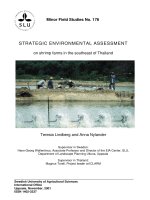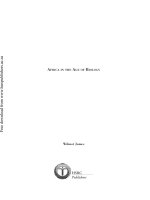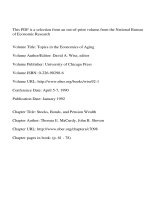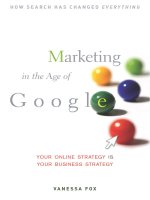Africa in the Age of Biology docx
Bạn đang xem bản rút gọn của tài liệu. Xem và tải ngay bản đầy đủ của tài liệu tại đây (259.45 KB, 24 trang )
AFRICAINTHEAGEOFBIOLOGY
WilmotJames
HSRC
Publishers
SCI 5_Africa Biology 007 8/25/04, 11:22 AM1
Free download from www.hsrcpublishers.ac.za
SocialCohesionandIntegrationResearchProgramme,AfricaHumanGenomeInitiativeOccasionalPaperSeriesNo.3
SeriesEditor:Prof.WilmotJames,ExecutiveDirector:SocialCohesionandIntegrationResearchProgrammeofthe
HumanSciencesResearchCouncil
PublishedbyHSRCPublishers
PrivateBagX9182,CapeTown,8000,SouthAfrica
www.hsrcpublishers.ac.za
©2004HumanSciencesResearchCouncil
Firstpublished2004
Allrightsreserved.Nopartofthisbookmaybereprintedorreproducedorutilisedinanyformorbyanyelectronic,
mechanical,orothermeans,includingphotocopyingandrecording,orinanyinformationstorageorretrievalsystem,
withoutpermissioninwritingfromthepublishers.
ISBN0796920737
ProductionbycomPress
DistributedinAfricabyBlueWeaverMarketingandDistribution,
POBox30370,Tokai,CapeTown,7966,SouthAfrica.
Tel:+27+21-701-4477
Fax:+27+21-701-7302
email:
Distributedworldwide,exceptAfrica,byIndependentPublishersGroup,
814NorthFranklinStreet,Chicago,IL60610,USA.
www.ipgbook.com
Toorder,calltoll-free:1-800-888-4741
Allotherinquiries,Tel:+1+312-337-0747
Fax:+1+312-337-5985
email:
SCI 5_Africa Biology 007 8/25/04, 11:22 AM2
Free download from www.hsrcpublishers.ac.za
Preface
The Human Sciences Research Council (HSRC) has established an occasional
paper series. The occasional papers are designed to be quick, convenient vehicles
for making timely contributions to debates or for disseminating interim research
findings,ortheymaybefinished,publication-readyworks.Authorsinvitecomments
andsuggestionsfromreaders.
ThispaperwaspresentedasthefirstannualJohnGerhartMemorialLectureat
theconferenceoftheAfricaGenomeInitiativeheldinCairofromMarch26to29,
2004.ConsiderationsofEgyptianscienceandartsandtheirlastingimpactonAfrica
areafittingtributetotheroundednessofJohnGerhart,himselfanartcollectorof
somenote,agiftedstory-teller,anenthusiasticbirder,aneconomistbytrainingand
ascientistbyinclination,aphilanthropistofgreatempathyandskill,andauniversity
presidentwithvisionandleadership.OneofthelastthingsJohnGerhartdidbefore
hediedwas tovisit thatbirder’sdream, theGalapagos Islands,oncedescribedin
thetitleofabookasEvolution’sworkshop(Larson2001).ItwasherethatCharles
Darwinspentagreatdealoftimeobservingthebehaviourofspeciesofbeingsthat
hadevolvedoverhundredsofthousandsofyearsinisolationandintheabsenceof
naturalpredators.Ifyouapproachedandtouchedthosebirds,theydidnotflyaway.
LikeJohnGerhart,theylackedthebiochemistryoftrepidation.
SCI 5_Africa Biology 007 8/25/04, 11:22 AM3
Free download from www.hsrcpublishers.ac.za
1
SCI 5_Africa Biology 007 8/25/04, 11:22 AM4
Free download from www.hsrcpublishers.ac.za
1
AfricaintheAgeofBiology
Harvard University’s RichardLewontininhis book Human diversity explainsthe
meaning ofwhatis known in theworldof mathematics asMarkovianproperties
operatingaspartofthedynamicsofphysicalandnaturalsystems.
The properties were named after the St Petersburg University trained Russian
mathematician whofirststudied them.AndreiMarkov (n.d.) isbest remembered
forhisstudyofsequencesofrandomvariableswherethefuturestateofavariableis
determinedbyacurrentvariablebutisindependentofthewayinwhichthepresent
statearosefromitspredecessors.So,forexample,indemography,informationabout
thesizeof,say,theEgyptianpopulationin2004dependsonlyonhowmanypeople
werealivein2003andonthebirthanddeathratesamongthevariousageandsex
cohorts,withouthaving toknowforpurposes ofpredictionhowthey cametobe
so.
Lewontintalks aboutMarkovianproperties inreference toanunderstanding of
speciesevolutionandparticularlythatofhominids,whereallweneedtoknowin
ourendeavourtopredictourfuturebiologicaltrajectoryisthepresentstateofour
genes.Ourgenesare,nodoubt,asLewontinputit,‘aconsequenceoftheirhistory’,
buthealsosaysthat‘thegenescurrentlypossessedbythespeciesareallthatmatters
for itsevolutionary future, irrespectiveof howitacquired thosegenes’(Lewontin
1995:147).
ProcessesofbiologicalevolutionworklikeMarkov’smathematicalchains,where
memoryisinterestingbutirrelevant;forthereis,asLewontinputsit,no‘memoryin
biology,onlyinbooks’(Lewontin1995:148).Afterthesequencingofthehuman
genome,hemightnotbequitesocategoricalabouttheapparentlyahistoricalquality
of genetic material, as molecular geneticists would certainly attribute ‘time’ to
SCI 5_Africa Biology 007 8/25/04, 11:22 AM1
Free download from www.hsrcpublishers.ac.za
WilmotJames
2
AfricaintheAgeofBiology
3
mutationaleventsthatarerecordedthereasjunkorrubbishortherealthing;but
thenagainthismattersnot,foritisaboutwhatoneneedstoknowinordertopredict
thefuture.History,howeveronemaywishtoconceiveofit,doesnotcountinthe
caseofMarkovianproperties.
By contrast, cultural systems such as modes of production, counting systems,
language,writing,buildings,art,andsoon,alldependvitallyonanaccumulation
of memory and well-functioning means of their transmission from generation to
generation.
Indeed,humanprogressinourstylesofmaterialandculturalmannerofliferelies
onourabilitytostoreandpassonmemory.Herethelibrary,thearchitecturalstore
ofwrittenhumanmemory,inbooksprincipally,orscrollsatthattimemorelikely,
playedacentral,indisputablerole.
And it is in illustrating the non-Markovian principle of muchofourcultural-
historicalprocessesthatLewontintalksaboutthelibrariesofAlexandria:‘[T]helow
stateofEuropeanculture,’hewrites,‘thatcontinuedlongafterthedisintegration
ofRomewasinpartaconsequenceoftheimmenselossfromthefundoftechnical
andhumanisticknowledgethatoccurredatthefinaldestructionofthelibrariesof
Alexandriain391.’Hethenadds:‘Incontrast,Muslimculturegrewataprodigious
ratebeginningintheseventhcenturypartlybecausetheknowledgeofclassicaltimes
– knowledge then unavailable to the Latin and Greek scholars of Europe – was
preservedinArabicmanuscripts’(Lewontin1995:148).
ThereisnoquestionthatthelibrariesofAlexandriawerecentraltothecityand
thebroadregionincludingwhattodayistheMiddle-East,NorthAfricaandmuchof
CentralandWesternEurope;thattheywerenottheonlyonestoexistbutwerepart
ofalargersetofinstitutionstoemergefromtheconcatenationsofcultural,scholarly
andotherareasoflearningandapplicationofwhatwerethentheadvancedsocieties
ofthispartoftheworld.
Theagencyoftheirruinisnotsocertain,neitherisitclearwhatitwasinvolume
andsubstance thatthelibrariesactually contained.Theinstitutionwascreatedby
PtolemyISoterfirstasamuseumtowhichhissonPtolemyPhiladelphusaddeda
library.ItwasJuliusCaesar,someclaimed,whodestroyedthelibrary,othersputthe
blameonChristianmobs,andyetotherspeddlethestorythatitwas‘[o]ntheorders
ofOmar,Caliph ofBaghdad,[that]theentirecollection ofbooks(exceptforthe
worksofAristotle)storedattheLibraryofAlexandriawereremovedandusedasfuel
toheatwaterforthecity’spublicbaths’(Librariesn.d.Accessed2004a+2004b).
Theevidenceforwhathappenedisthin,andJamesHannan’sassessment,balanced
itwouldseem,isthat‘CaesarwasmostprobablyresponsibleforthelossoftheRoyal
SCI 5_Africa Biology 007 8/25/04, 11:22 AM2
Free download from www.hsrcpublishers.ac.za
WilmotJames
2
AfricaintheAgeofBiology
3
Library’;asecondlibrarycalledtheSerapeum‘ceasedtobewhenaChristianmob
tore it down to the foundations under the leadership of the orthodox patriarch
TheophilusafterhehadreceivedwordfromtheEmperorTheodosius’(Librariesn.d.
Accessed2004b).ThestoryaboutArabdestruction,bytheCaliphofBaghdad,isa
myth,withoutanyevidenceitwouldseem.And,ofcourse,itisnotthefirsttime
thatBaghdadhasbeenblamedforsomethingitdidnotdoornotblamedforwhat
itdiddo.
Thispaperstartswiththisstoryinpartbecausesome,ifnotmost,ofAristotle’s
workwashousedintheAlexandrialibrary;andthisgreatfigure,principallyknownfor
hisphilosophicalscholarship,wasalso,asthingstendedtobethen,oneoftheworld’s
firstembryologistsanddevelopmentalbiologists.ThissameAristotle,whocollected
and dissected embryos, and observed them closely, got the sex determination of
humanbeings,wenowknow,terriblywrong.Heclaimedthatthesexofapersonwas
determinedbytheheatofthemalepartnerduringintercourse.Themoreheatedthe
passion,thegreatertheprobabilityofmaleoffspring.Hehadcounselledelderlymen
toconceiveinthesummeriftheywishedtohavemaleheirs.ScottGilbertinhistext
DevelopmentalbiologysaysaboutAristotlethathe‘promulgatedaverystraightforward
hypothesisofsexdetermination.Womenweremenwhosedevelopmentwasarrested
too early’(Gilbert 2000:523).With nosenseat allofthe microbiological,never
mindthemolecularbiological,Aristotleandmanysincethenhadnotaclueabout
theroleofXandYchromosomes,geneticheredityandtheboosttohumansurvival
ofsexualasopposedtoasexualreproduction.
Still,Aristotlewascrucialinthehistoryofbiologyandmedicineforhispainstaking
observations,hismethod ofpursuing somekey questionsabouthumanity andits
evolution,andhisunusualpreoccupationwithembryology,eventhoughhecould
notrecognisethatsexualasopposedtoasexualreproductionwasnature’smasterful
secrettohumanvarietyandsurvival.
Egyptanditshistoryarewhatlieattheheartoftheearlyhistoryofmedicalbiology,
engineering,physics,mathematics,architecture,artandliterature.Althoughscholars
todaytendto thinkonly ofearly Egyptians’knowledgeofthemedicalbiology of
mummificationandtheirunderstandingofanatomy,thebiochemistryofsoftand
hard tissue,decay and preservation,it is clearas Sameh Arab,AssociateProfessor
of Cardiology atAlexandriaUniversity writes, that ‘[s]omekindofmedicine was
alreadypracticedinEgyptintheearliestprehistoricdays’.HereferstotheKahung
gynaecology papyrus dating to 1825 BC which ‘describes methods of diagnosing
pregnancyandthesexofthefetus,toothacheduringpregnancy,diseasesofwomen,
aswellasfemininedrugs’andtotheEdwinSmithpapyrusof1600BC,whichcanbe
SCI 5_Africa Biology 007 8/25/04, 11:22 AM3
Free download from www.hsrcpublishers.ac.za
WilmotJames
4
AfricaintheAgeofBiology
5
describedasareferenceworkoninternalmedicine,dealingasitdoeswith‘diseasesof
theeye,skin,extremities,gynecologyandsomesurgicaldiseases’(Arabn.d.).There
is,ofcourse,muchmoretobesaidaboutancientEgyptianmedicineanditslinkwith
modernbiology,butthatwillhavetobeleftforanothertime,anotherplace.
...
Among some recentlyfoundfossils left in the StillBayarea along South Africa’s
southernmostcoastlineby whatmust havebeen ancestralKhoi orSan peopleis a
pieceofdecoratedochre,aformofironore.ItisnamedinAfrikaanstheblombos
(flower-bush)ochreafterthecavewherethefossildiscoverieswerefound.Thename
isanoddlinguisticconstruction,beingpartofthevocabularyusedtodescribethe
indigenousfaunavarietyofthesouth-westernCapeknownasfynbos(fine-bush),to
befoundonlythereinallofitssplendidvarietyandage.
ChristopherHenshilwoodoftheStateUniversityofNewYork,thearchaeologist
diggingatthissite,describestheredochreas‘measuringtwoandthreeincheslong’,
‘firstscrapedandgroundsmoothtocreateflatsurfaces’,and‘thenmarkedwithcross
hatchesandlinestocreateaconsistentcomplexgeometricmotif’(Highfieldn.d.).
Whatthesemarkingsmeanisopentodebate.Onemorecautiousinterpretationis
that theyare‘tally marks’,‘makingthem the oldestform ofrecorded countingever
found’[BlombosCaven.d.].Thereisnoindependentsourceofproofastowhatitis
theseancestorswerecounting.Itcouldhavehadsomethingtodowiththeordinary
material habits of hunters and gatherers, and likely the tallying of animal kills. Or,
perhaps,itrelatedtotradingwithneighbours,or,moreonadeeplyexistentiallevel,
observingtheastronomical,with,asGeorgesIfrahputsitsobeautifullyintheUniversal
historyofnumbers,afascinationwiththeregularityof‘thephasesofthemoon,theeternal
returnofdayandnight,thecycleoftheseasons’or,wemightadd,giventhecontext,the
ellipticalphasesofthetidesofgreatandmarvellousoceans(Ifrah2000:xvi).
Inthehistoryofcounting,theSanandKhoiperhapsjoinedotherhumanbeingsand,
inobservingthatbirdshavetwowings,animalsfourlegs,andtheytenfingerstotheir
handsandtentoestotheirfeet,developedanumberingsystemusingtheirfingersortoes
asthebaseten,themostcommontypeofcountingfoundamongearlierpeoples.
OrperhapstheyjoinedtheMayans,Aztecs,CeltsandBasqueswholookeddown
attheirfeetandrealisedthattheirtoescouldbecountedlikefingersandchosethe
muchmoreunusualarithmeticbaseof20.
SCI 5_Africa Biology 007 8/25/04, 11:22 AM4
Free download from www.hsrcpublishers.ac.za
WilmotJames
4
AfricaintheAgeofBiology
5
Or again, perhaps, they joined the SumeriansandBabylonians,whochosefor
reasonsunknowntoustodayabaseof60,whichweuseinrespectofmeasuringtime,
withanhourbeing60minutesandaminutebeing60seconds;orthemeasurement
ofacircleinto360degrees,eachof60minutesdividedinto60seconds.
Countingis,ofcourse,thecrucialfirststep;butitisnotarithmeticanditcertainly
does not approach mathematics: the earliest known evidence for the arithmetic
foundationsofmodernmathematicswasfoundinElamandMesopotamia,Sumeria,
AncientEgypt,Crete,GreeceandRome.
The mathematics of Ancient Egypt were quite obviously remarkable in their
sophistication –proofof this are theremainsof one of thegreatwonders of the
world: the pyramids, which were engineeredwithextraordinaryprecision and on
ascalethatstretchesthemind.And,inconfirmationofthetestofallconstruction
tests,theystillstandtoday,strippedperhaps,vandalisedyes,lootedcertainly,butstill
thereinalloftheirbeautyandgrace.
Buildingthepyramidspresumedexpertiseinstonecutting,engineering,mathematics
andphysics,nottomentionunderstandingandmasteringthebasicsofthephysicsof
levers, navigation and water behaviour in moving these monstrous blocks of stone
downthegreatriverNile.Theyare,intheirpracticalityandcomplexity,stunningto
us;lookingaswedoinadmiration,backwardsathistory.
This venture into biology and Africa is by way of counting and arithmetic then;
becauseitisaninterestingdigressionintotheepistemologicallineageofmathematicsand,
forreasonsthatwillbecomeclear,becausethereisacriticalmathematicalsidetohuman
geneticswhichalsoindicateswhereAfricastandsinrelationtomodernbiologytoday.
Themassmediahasover thelast fewyears beenreplete withnews andfeature
storiesaboutdeoxyribonucleicacidorDNAandwhatitmeansandmightmeanfor
medicine,forensics,humanoriginsandpopulationancestry.Inpart,themediahas
beencelebratingbecauseofthe50yearsofprogressthathavepassedsinceDNAwas
firstdiscoveredashavinga double-helicalarchitecture, andin partbecause ofthe
sometimesover-dramatisedadvancesinunderstandingandtreatinginheriteddisease
regimesmadepossiblebythesequencingofthehumangenome,thefullrepertoireof
ourbiologicalinstructions.
Threebillionbase-pairnucleotidesmakeupthehumangenomeandtheseaddup
toanunknownnumberofgenesintheregion,itissaid,ofabout32000.Nucleotide
informationisdigital,inthattwoelementscombineinamannerfollowingtheruleof
A(foradenine)combiningwithT(forthymine)andG(forguanine)andwithC(for
cytosine),makingupachain–thefullextentofwhichwehavestilltounderstand
fullyfromthepointofviewoffunctionandpurpose;butwedo,ofcourse,knowthe
SCI 5_Africa Biology 007 8/25/04, 11:22 AM5
Free download from www.hsrcpublishers.ac.za
WilmotJames
6
AfricaintheAgeofBiology
7
exactsequenceofallthegeneticlettersofthenucleotidealphabet.Indeed,genomes
areencyclopaediasofgeneticmaterialscollectedquitemechanically,nottoprovea
setofhypothesesbutsimplytodocumentwhatthereis–thehypothesescoming,as
itwere,later.Andtheynowcomethickandfast.
Mathematicswas required to countthe DNA.Mathematicalmolecular biology,
calledbioinformatics,isrequiredtomakesenseoftheDNA,identifyanddiscoverthe
candidategenesthataretheparticularstringsorchainsofDNAandbegintoascertain
theirfunction.DescribedoncebytheSouthAfricanbornNobelLaureate,Sydney
Brenner,intypicallysardonicandintellectuallydismissivemannerasanewbrandof
libraryscience,bioinformaticsispartoftheessentialequipmentofeverygenehunter.
Heorsheisthepersonwhocanmasterthesoftwareanddatamanagementassociated
withmillionsandbillionsofbitsofdigitisedinformationthatadduptogenesand
combinations of genes that programme the various parts of the human body, its
maintenance, the death of cells and eventually the demise ofthe entire organism.
Itisquiteabusiness,madepossiblebytheexponentialgrowthofcomputerisation,
andinparticulartheworkofapersonafterwhomthewriter’svisitingprofessorship
attheCaliforniaInstituteofTechnologyisnamed,GordonMoore.GordonMoore,
founderofIntel,predictedthatthenumberoftransistorsthatcouldbeplacedona
computerchipwoulddoubleevery18months,andsoithasbeenforover30years.
Butpeopleshould notbemisledby SydneyBrenner’slovely,dolorous senseof
humour:theinformationdemandsingenomicsarestaggering.Thegenomecontains
twokindsofdigitalinformation,onethatencodestheproteinandRNA‘molecular
machinesoflife’,andtheotherbeingtheregulatorynetworksthatspecifyhowthese
genesareexpressedintime,spaceandamplitude.
DNAinformationislayeredandarrangedinahierarchy,startingwiththegene,
then the RNA, then the protein, then the protein interactions, then the protein
complexes,thenthenetworksof proteincomplexes ina cell,then thetissues and
organs,thentheindividualorganism,followedbypopulationsandtheecosystemsin
whichtheylive.Inthiskindofdiscoveryscience,masteringsuchvastquantitiesof
informationtoanswerimportantquestionsisaskillandanart.
Andthehardware?Thefirstautomatedsequencingmachinetookaday,in1986,
tosequence250ofthethreebillionbasepairs.Ittookthehumangenomeproject
tenyearstosequencethehumangenome,twoyearsshorterthanpredicted;andthe
privatecompanyCelerawithitsso-calledshotgunapproachtooklessthanthepublic
consortium’s ten, using a warehouse of computers to do so. ‘With single-DNA-
molecule sequencing, we foresee a time’ say the inventors of the first sequencing
machine‘whentheentiregenomeofanindividualcouldbesequencedinasingle
SCI 5_Africa Biology 007 8/25/04, 11:22 AM6
Free download from www.hsrcpublishers.ac.za
WilmotJames
6
AfricaintheAgeofBiology
7
dayatacostoflessthan$10000(comparedtothe$50millionitwouldcosttoday)’
(Hood&Galas2003:131).
The fullhuman genome ispublicly available,andif onehasthe hardwareand
Internet connection,forfree, anyonecandownload that partof the genomethat
wouldbeofinteresttothem.Wehavetothank,amongothers,theWellcomeTrust
for that.And so,inAfrica, thereare institutionsthatspecialise inbioinformatics,
although it is not known at what level of information scientists are working in
Burkina Faso, Cameroon, Egypt, Ethiopia, Kenya, Malawi, Mali, Nigeria, South
Africa,Tanzania,Tunisia,UgandaandZambia.AnAfricanBioinformaticsNetwork
(Abionet) has as affiliated institutions the University of Benin, the International
Centre for Insect Physiology and Ecology (ICIPE), the South African National
Bioinformatics Instituteat the Universityofthe WesternCape,the Universityof
Pretoria, the University of Mali and several other institutions. Abionet’s mission
summarisestheabidingpassionofgeneticistsworkinginAfricatoday:
The purpose of the network is to enableAfrican scientists to unlock the scientific
potential of recent advances in genomics in order to accelerate medical advances
against infectious diseases such as malaria, tuberculosis and HIV/AIDS that are
still killingso manyin Africa.The recentavailability ofgenomic datafrom awide
range of organisms,including common African pathogens,presents new challenges
for biologists, sociologists, mathematicians and computer scientists alike. (African
BioinformaticsNetworkn.d.)
The human host to disease has been sequenced, as have the genomes of the
pathogens. It is the interaction between host and pathogen which has to be
understood properly,and remedies andinterventionsdeveloped. Lastyear, about
a fifth of the inaugural conference of the Africa Genome Initiative, entitled the
‘HumanGenome andAfrica’, wasdevotedtowhat iscalledpathogen genomics.
FundedbytheWellcomeTrust,itwasindeedamini-conferenceinthebiggerevent.
Currently,scientistsarelookingcarefullyattheethicalandlegalconsiderationsin
drug and vaccine discovery and will probably focus on drugs and vaccines for
effectivepublichealthcareresponsestoAfrica’sthreekillerdiseasesattheconference
in2005,likelytobeheldinKenya.
At the inaugural conference, virologist and Nobel Laureate David Baltimore
arguedthatcurrentHIVvaccinedevelopmentisunlikelytobesuccessfulbecauseof
HIV’sinstabilityandrapidevolutionarymutation.Heputforwardtheproposition
thatanimmunityproteinrequiresengineeringandhasallocatedacompanytowork
ontheidea.
SCI 5_Africa Biology 007 8/25/04, 11:22 AM7
Free download from www.hsrcpublishers.ac.za
WilmotJames
8
AfricaintheAgeofBiology
9
MathewBerrimanoftheWellcomeTrustSangerInstitute,whoseareaofexpertise
isthemalariaparasitePlasmodiumfalciparum,saidgenomicsdoadvanceresearchbut
that‘inthenextfiveyears,itisunlikelywewillseeanybenefits.Overthenext10
years,someknowledgewillseepthrough,andaidunderstandingofthemechanisms
ofdrugresistance.Butthemostsignificantimpactswillbeinthe20yeartimescale,
withdrugsandvaccinesfortreatingthedisease’(GenomeNews,Supplementtothe
Mail&Guardian6June2003,p.4).
Thenthereisalsothestoryoftuberculosis,astoldbyStewartColeoftheInstitute
Pasteur.TuberculosishasadreadfulsynergywithHIVandislargelyasocialdisease
asaconsequenceofpovertyandpoorhousing;onthebacterialandviralside,itisalso
nowbetterunderstoodasaresultofgenomics.‘Geneticmapping,’hesays‘suggested
thehumanandanimalstrainsoftuberculosisoncesharedaprogenitor,butevolved
independently’(GenomeNews, Supplementto theMail &Guardian6June2003,
p.4).Aremedy,though,isnotinsight.
It maybe,in the North, thatoneresult will betheemergence of personalised
medicine, of having drugs and interventions designed specifically for the unique
modality ofone person’s diseaseprofile; becausehavingso ‘manypolymorphisms
associated with disease susceptibility brought DNA diagnosis to medicine and
openedthepathwaytotrulypredictivemedicine,wheretherisksofdiseasecanbe
identifiedinadvanceofsymptoms’(Hood&Galas2003:131).WeintheSouth,
aselsewhere,needtoworkhardatfiguringouthowtomakegenomicsrelevantto
clinicalpracticeinprivateandpublicmedicine,sothatitdoesnotremainwiththe
privilegedandelitefew.
IntheSouth,itisalsoaboutbringingkillerdiseasesundercontrol.Thatisajobonits
own,requiringextraordinaryinvestmentthatsimplyisnotthereoreasilyforthcoming.
Inthe,Ibelieve,undervaluedreportGenomicsandworldhealth,theauthorssaythe
followingintermsofwhattoexpectfromtheprivatesector:‘Theprivatesectordoesnot
investinresearchaimedatdiagnosticsortherapeuticsfordiseasesthatarepredominant
indevelopingcountriesbecausethepopulationsmostlikelytoneedthemdonothave
purchasingpower. In1997,forexample,itwasestimatedthatlowandmedium
incomecountriesaccountedforonly20%oftheglobalpharmaceuticalmarket,even
thoughtheymadeupover80%oftheworld’spopulation.’Theygoontoaddthat
althoughpublicresearchfundinghasconsiderationsotherthanprofitmaximisation,
itisneverthelesssadlythecasethat‘pneumonia,diarrhea,tuberculosisandmalaria,
whichtogetheraccountformorethan20%ofthediseaseburdenoftheworld,receive
lessthan1%ofthetotalpublicandprivatefundsdevotedtohealthresearch.In1998,
outoftheUS$70billionglobalspendingonhealthresearch,onlyUS$300million
SCI 5_Africa Biology 007 8/25/04, 11:22 AM8
Free download from www.hsrcpublishers.ac.za
WilmotJames
8
AfricaintheAgeofBiology
9
was directed to vaccines for HIV/AIDS and US$100 million to malaria research’
(Weatherall,Brock&Chee2002:17–18).
A five to 20-year time span for results from the revolution in genomic and post-
genomicbiomedicinetomakearealdifferenceinAfricadoesnotsoundrightandis
surelyunacceptable;itisareflectionoftheirrationalityofaglobalsystemthathastobe
redirectedbyfocusedAfrican-sourcedinvestments,bygovernments,increatingproperly
functioningpublichealthsystemsbuiltinpartaround‘thinkinginstitutions’,andthe
university-privatesectorpartnershipsingenomicresearchanddevelopment.Itisindeed
apleasuretonotethecreation of theInstituteforInfectiousDiseases andMolecular
MedicineattheUniversityofCapeTownandthenewBiosciencesFacilitythathasbeen
establishedinKenya.Also,ofcourse,AinShamsUniversity’scentreforbio-engineering,
whichisanotheremergingcentreofexcellencealongtheselines.Developmenthereis
whollyourresponsibility,formanyofushaveallowedthelittlewehadduringcolonialism
tocollapse,withofcoursesomenotableexceptions.Anditisalsoourresponsibilityto
investgenerouslyinAfricanentrepreneursinthebiomedicalandbiotechnologicalarenas
byprovidingtheavenuesforventurecapitalandtechnicalexpertise;allthishelpedalong
bynorthernhemispherecorporatepartnershipsand,whennecessary,aid.NEPADhas
alreadymovedintothisarea,whichiswelcome,butthescaleofthechallengeneedstobe
matchedbythescaleofthenecessaryinvestment.
...
Marketing information for a new diet tablet called Hoodia gives the nutritional
contentasfollows(asrequiredbyUnitedStateslaw):
Chromium100mg
Calciumpyruvate48mg
Hoodiagordonii20:150mg
Citruspectin40mg
Grapefruitseedextract30mg
Prune30mg
Allthisiscaffeinefree,ephedrafreeandstimulantfree–‘adietpillunlikeany
other’,theadvertisementsays;90tabletsforjust$29,95!
Hoodia, it turns out, is a natural appetite suppressant used in ‘[t]he harsh
environmentsinwhichtheKung!Bushmenhavelivedforthousandsofyears’;here
wherehuntersareonthehuntsometimesfordays,Hoodia‘suppresseshunger’and
meetsconsiderableenergyrequirements.‘The Sancall thecactus !khobaand have
SCI 5_Africa Biology 007 8/25/04, 11:22 AM9
Free download from www.hsrcpublishers.ac.za
WilmotJames
10
AfricaintheAgeofBiology
11
been chewing on it for thousands of years to stave off hunger and thirst during
long hunting trips in their parched KalahariDeserthome,’writesLeonMarshall
forNationalGeographicNews(Marshall2003).Expertnaturalbotanists,theKung!
Bushmencanreadilyidentifymorethan300differenttypesofplantswithdifferent
properties,ofwhichHoodiaisakeybuthardlytheonlysuchplant,leavingtheperhaps
naiveorindifferentKung!Bushmenopentoexploitationbymodernpharmaceutical
companies,seekingaprofitbyturningnaturalremediesintocommercial,biomedical
interventions.And,indeed, pharmaceuticalcompanies havebegun to,as theyput
it,‘bio-prospect’inextremeandharshenvironmentsthat‘couldmakepossibleeven
morefantasticscientificandcommercial feats’.BillionsofUS dollarsareatstake,
saysElizabethWeiseofUSATodaywithasenseofthejournalisticallyspectacular:
‘Possiblediscoveriesincludedetergentsmadefromenzymesthatworkmuchbetter
thanexistingproductsincoldwater;colorpigmentsincloththatdon’tdegradein
heat,madefrommicrobesthatthriveinhellishlyhotwater;andantibioticsstrong
enoughtokilloffeventhemostdrug-resistantbugsthatpopupinourhospitals’
(Weise2004:9D).
Some of these organisms living in extreme places fall under no single national
authority, such as those in Antarctica, the deep sea-bed or even, who knows,
the moonandMars; by nomeans a far-fetchedidea,given the recentlanding of
scientificallyloadedroversontheplanetnearesttoours.So,forexample,‘activities
ontheworld’smostinhospitablecontinent[Antarctica]areoverseenby54countries
thatarepartytotheAntarcticTreatySystem’.Asbio-prospectingdoesnotfallunder
thistreaty,thescientificadvisorstotheUnitedNationsrecentlypresentedareport
outlining more comprehensive and inclusive international agreements to include
protectionagainstwhatarecalledbio-prospectingandbio-piracy.
IntheinstanceofHoodia,aninterestingmodelarose,thoughthejuryisstillouton
whetheritisworkingornot:theSouthAfricanCouncilforScientificandIndustrial
Research(CSIR),inwhoselaboratoriesP57wasidentifiedasHoodiagordonii,will
payarepresentativebodyoftheSaneightpercentofmilestonepaymentsmadeby
itslicensee,theUnitedKingdompharmaceuticalcompanyPhytopharm,duringthe
drug’sclinical development.Thispayment cameto morethan$1million. Butthe
biggestrevenueswouldderivefromtheagreedsixpercentinroyaltiespaidtothe
Sanifand whenthe drugismarketed byPfizer,which inturn hasbeen licensed
by Phytopharm. National Geographic News remarks that ‘given the international
demandforobesitydrugs,themarketforP57couldruntobillionsofdollars’.
Unorganised,poor,marginalised,abused,andlurchingtowardsextinction,these
oldestofancient peoplesbear geneticmaterials thatareof thegreatestdepthand
SCI 5_Africa Biology 007 8/25/04, 11:22 AM10
Free download from www.hsrcpublishers.ac.za
WilmotJames
10
AfricaintheAgeofBiology
11
mostdiversehistorically,likelytheancestorstoallofus.Tothem,Hoodiamaybring
somefortune,somesalvation.Ithasinvitedorganisationalstructuresandaleadership
thatwerenottherebefore,atleastnotwiththesameclarityofpurpose,toreceive
anddistributefundstotheSancommunity,enteringtherebythedomainofpolitics;
for whoisthe Sancommunity,and on whatbasisand onwhoseterms do those
whodistributescarceresourcesdistributethem,especiallyinacommunitythatisso
lackingineventhemostelementaryofservices?
AndsotheSouthAfricanSanCouncilemergedin2001torepresentsomeSan
tribes,asdidaTrust,whosepurposeitis‘touseincomereceivedfromtheCSIRfor
generalupliftment,developmentandtrainingoftheSancommunityapprovedbythe
BoardofTrustees’.ThisBoardconsistsofsevenindividualsdrawnfromtheranksof
theSan,NGOsandtheSouthAfricanGovernment.Humanrightslawyersandthose
withmodernprofessionalskillswhocouldhelprepresenttheinterestsofminority
andindigenouscommunitiesatlocal,regionalandworldbodiescameforthtoassist;
heretheSouthAfricanSanInstitute(SASI)hasplayedaparticularlybeneficialrole.
Thelegalissue,onethatpertainsworldwideincludingAfrica,concernstheroleof
patentsinrespectofbiologicalandbotanicalknowledge.
Recently the United Nations expressed its concern over bio-prospecting in
Antarcticabypharmaceuticalcompaniesinsearchofuniqueorganismsthatcanbe
usedforcommercialpurposes.Thebio-prospectors,whospeakofthelastfrontiers,
searchinwhatareknownashydrothermalevents:thedeepsea-bed,thewatercolumn
ofthehighseasandpolaricecaps.
The United Nations University, based in Tokyo, recently published a report
recommendingarangeofrulestoregulatebio-prospecting.‘Isolatingandextracting
the substances that allow organisms to survive in one of the earth’s harshest
environmentscouldleadtonewcancertreatmentdrugs,antibioticsandindustrial
compounds,’ the report says. One valuable substance is glyco-proteins, which
functionasantifreezeinsomeofthefishthereandpreventthem,obviously,from
freezingtodeath.Ifisolatedandproduced,antifreezesubstancescouldbeusedfor
‘raisingthefreezetoleranceofcommercialplants,improvingfarmfishproductionin
coldclimatesandextendingtheshelflifeoffrozenfoods’(Stoddardn.d.).
Thereportsumsupthedifficulties:‘Companiesareconcernedbecausethereisno
titleintheseresources ownershipisundefined.Theycanspendmillionsdeveloping
a product with questions remaining about ownership,’ said one of the co-authors
of the report, Sam Johnston. On the other hand, scientists’ concerns are that the
‘commercialnatureofthiswilltakeawayfromthetransparencyandcooperationwhich
isthehallmarkofAntarcticresearch,’Johnstonreportedlyadded.TheConventionon
SCI 5_Africa Biology 007 8/25/04, 11:22 AM11
Free download from www.hsrcpublishers.ac.za
WilmotJames
12
AfricaintheAgeofBiology
13
BiologicalDiversity,whichemanatedfromthe1992RiodeJaneiroEarthSummit,a
modelofitskindinregulatingbio-prospectingonpaper,simplyhadnotworked,with
theresultthatacountrylikeBrazil,withitsequatorialforests,feltpressedtocloseits
nationalbordersandprohibitanyofitsbiologicalmaterialsfromleaving.
Ofcourse,thesearchtofindwithinnatureanswerstoatsometimesdifficultand
atothertimesephemeralproblemsofhumankindopensupethicalandlegalfrontiers
that involvethedisciplines that worryaboutthese things: law, philosophy,ethics
and,asitturnsout,anthropologyandsociology.
Acurrentresearchthemeconcerns theethical andlegal issuesinvolved indrug
andvaccinediscovery,theideabeingtocharttheterrainforAfricainanticipation
ofhavingsuchinterventionstodealwith,giventhecontinent’ssubstantialdisease
burden.RuleshavetobedefinedaccordingtowhichAfricanpopulationscanbeused
assubjectstodiscoverthegeneticbasisofsomeinherited(andacquired)diseases,to
testvaccinesanddrugsindevelopment,andtostartmakingclearsenseofwhatcan
bedonetostartresistingthatpoorprecedentandbadhabitsetintheUnitedStatesof
patentingeverythingthatmoves,includingvariousbitsofhumangenomesequence.
At the same time,though,oneobviously understands the need for companies to
protect,justifyandrecouptheirconsiderableinvestments.
ButmanydrugsthatcanmakeahugedifferencetothehealthofAfricanpopulations
arenotcoveredbypatentlaw.Atthe2003conferenceoftheAfricaGenomeInitiative,
GordonDouganofImperialCollege’sCentreforMolecularMicrobiologycalledon
Africancountries totake advantageof newgenomictechnology anddevelop their
owndrugs,andmentionedIndiaandCubainparticularinthisregard.
Technologyassociatedwithgenomesequencinghasmadetheprocessofdrugand
(some)vaccinedevelopmentmuchsimpler.
Dougansaidthat‘thedevelopmentofvaccinesindevelopingcountrieshadfallenback
inthelast20yearsandwasnowconcentratedinthehandsoffourmajormultinational
companies’.Genericvaccines,Gordonadded,‘couldbemadebyanybody’and‘Africa
shouldalsostartdevelopingvaccinestoimmunizeitspopulationagainstdiseaseswhich
areprevalentinthisregion’(Daniels2003:6).AseniorAfricanscientist,whoisalsoa
memberoftheHumanGenomeOrganization(HUGO),light-heartedlyobservedthat,
fromthepointofviewofmanufacturingsomegenericdrugsandvaccines,itwould
be like ‘brewing beer’, and without patents to worry about, quite straightforward.
Therefore,whatAfricaneedsareentrepreneursinthisfieldandsomeventurecapital
togetthem going. Byno meansa smallpoint,as Africalacksentrepreneursin the
biotechnological,medicalandpharmaceuticalareas.Itisnotenoughtohavethescience
andtechnology;entrepreneursarecrucialfordevelopmentandsuccess.
SCI 5_Africa Biology 007 8/25/04, 11:22 AM12
Free download from www.hsrcpublishers.ac.za
WilmotJames
12
AfricaintheAgeofBiology
13
Thenthereisthequestionofgeneticallymodifiedfoods.Attentionwasfocused
onthisissuebyZambia’srefusaltoacceptgeneticallymodifiedcropsasaidbecause,
saidDrinahNyirenda,aformerUniversityofZambiadeanandexecutivedirector
oftheZambianProgrammeAgainstMalnutrition,ofthecountry’s‘concernsabout
the effect that genetically modified food would have on the environment and
maintainingthediversityoflocalcrops’(Nyirenda2003).
ForAfricaasawhole,thestoryismorecomplicated.SouthAfricaistheonlycountry
on the continent with commercialised, genetically modified crops. The director of
Genetic Resources at the Department of Agriculture, Dr Shadrack Moephuli, is
quotedasbeinganupbeatsupporterofwhatgeneticallymodifiedcropsmightbring
tothe country’svast population of poorpeople:‘South Africa’s impoverished rural
peoplewouldbethemainbeneficiariesofcontroversialgeneticallymodifiedorganism
technology.’He added: ‘Atthe moment trials are ongoing with maize andcotton.
Thesearebeingdonewithsmallscalesubsistencefarmersinruralareas.Thesearethe
kindsofareaswhereitisimportanttorealizethebenefitsoffoodsecuritythatcancome
withcropsthatareresistanttopests’(Seccombe2000).Morethanmereexperiment,
SouthAfricahad163000hectaresofgeneticallymodifiedyellowmaizeandafurther
18000hectaresofgeneticallymodifiedcottoninthe1999to2000season.
Still, South Africa is a signatory to the BioSafety Protocol, and its openness
towardscommercialised,geneticallymodifiedcropsmightbringitintoconflictwith
theSouthernAfricanDevelopmentCommunity(SADC)whosemembersdifferin
theirstance.Malawi,NamibiaandZimbabwe,forexample,donotacceptgenetically
modifiedcropsunlesstheyaremilledfirst;andonlythelattercountryisconducting
researchonthecommercialproductionofvariousgeneticallymodifiedagricultural
products.
Theirony ofhaving someAfrican countries,whichin thepast couldfeed their
people, now turning back genetically modified seeds or crops is only made less
painfulbywhatisdescribedastheaggressivelyself-interestedcommercialstanceof
theUnitedStatesinitssearchformarketsintheEuropeanUnion,havingsecondary
consequencesforthemuchsmallerandprobablylessimportantmarketsofAfrica.
ReferringtotheUSchallengetotheEUattheWorldTradeOrganization,Amadou
Kanoute,theAfricaDirectorofConsumersInternational,saidthattheUnitedStates
lawsuitagainsttheEuropeanUniontoeaserestrictionsandstandards‘willboomerang
againsttheUnitedStatesbecausesomanycountriesareintheprocessofdeveloping
regulatory systems for genetic modification’. In fairly typical and not altogether
inaccuratelyamanner,KanoutesaidthathebelievestheBushadministration’smain
goalinlaunchingtheWTOcaseisnotconcernaboutAfricafoodproductionand
SCI 5_Africa Biology 007 8/25/04, 11:22 AM13
Free download from www.hsrcpublishers.ac.za
WilmotJames
14
AfricaintheAgeofBiology
15
hunger,buttheexportofUScorntothe$300millionEuropeanmarket(Kanoute
2003).
Whilethebigboysfightitoutthen,Africancountriesarekeentoadoptwhatis
knownasbio-safetymeasures,inprotocolsgloballyandlegislationnationally.But
thisclamourtoregulatehidesanalarminglackofcapacitytodiscriminatebetween
whichgeneticallymodifiedcropsaregenuinelyharmfultopeople,biodiversityand
theenvironment,andinwhatmeasure,andwhicharenot,bymanygovernments
lackingexpertiseinmodernagricultureandfoodproductionintheeraofmolecular
biologyandgenomes.Africacouldcertainlydowithacontinentalresourcetoprovide
goodadvicetogovernmentsintheareaofgeneticallymodifiedfoods,backedupby
goodscience.Possibly,itisacontinentalresourcethatcouldbeprovidedbytheNew
PartnershipforAfricanDevelopment(NEPAD)too;andtherearealsootherglobal
agenciesliketheWorldHealthOrganization.
Peopleshouldnotbefooledbytheclaimthatgeneticallymodifiedfoodsarethe
answertoproblems ofpoverty,malnourishmentand developmentinAfrica.That
wouldbetomisdiagnosetheproblem,poorlyunderstandthemotivesofcommercial
bio-agriculture and naively trust governments of the North about the altruistic
benefitsofacceptingtheirexports.GeorgeMonbiotwritesasfollowsintheGuardian
of9March2004:
GMtechnologypermitscompaniestoensurethateverythingweeatisownedbythem.
Theycanpatenttheseedsandtheprocessesthatgiverisetothem.Theycanmakesure
thatcropscan’tbegrownwithouttheir patentedchemicals.They canpreventseeds
fromreproducingthemselves.Bybuyingupcompetingseedscompaniesandclosing
themdown,theycancapturethefoodmarket,thebiggestandmostdiversemarket.No
oneinherrightmindwouldwelcomethis.
Hegoesontotalkabouthowsomegeneticallymodifiedcropsdohavehigheryields
and how some too can be changed to have more nutrients, ‘though both these
developmentscanbeoverhyped’andrequirerigorousscrutinybeforesuchcropsare
importedandused.Monbiotmentionstheprojecttoengineersweetpotatotoresist
virusesinKenyaashavingcollapsed,despite$6millioninfundingfromMonsanto,
TheWorldBankandtheUnitedStates,whereasacrosstheborder,inUganda,afar
cheaperandconventional‘breedingprogrammehasdoubledsweetpotatoyields’.It
turnsout,too,thattheotherKenyaprojecttoengineervitamin-enrichedricealso
collapsedbeforestartingbecauseitappearsasif‘malnourishedpeopleappearnotto
beabletoabsorbVitaminAinthisform’(Monbiot2004:23).
SCI 5_Africa Biology 007 8/25/04, 11:22 AM14
Free download from www.hsrcpublishers.ac.za
WilmotJames
14
AfricaintheAgeofBiology
15
Still, Monbiot overstates his point; what we simply need is the capacity for
rational,scientific,common senseassessments ofwhatis goodfor usandwhatis
not;andwhilewearebusydoingthat,weshouldnotwreckbutbuildandrebuild
theagriculturaleconomiesthatinthepastfedAfrica’speople.Forbiotechnologyin
foodproductionisneitherthepanaceanortheevilimperialplotitismadeouttobe;
everythingdepends,asalways,onwhatwemakeofanddowiththebiotechnology,
whichinturndependsonwhatwemakeofouragriculturaleconomies.
...
Public-privatepartnershipsinthebiotechnologyerabetweenknowledgecentressuchas
universitiesorinstitutesand(especially)pharmaceuticalcompaniescanbeaslucrative
astheyarechallenginginthegovernancearea:arecentcontroversyattheUniversity
ofCaliforniaatBerkeleyoverwhetheracorporatefunderofamajorscienceproject
shouldhaveaseatonthegoverningbodyoverseeingtheworkindicatesthattheissue
isgermaneeverywhere andnotonlyinAfrica,wherethereisastandingaccusation
fromcertainquartersthatAfricaninstitutionsaremereplatformsfortheinterestsof
themultinationalpharmaceuticalcompaniesanddonorcountryinterestsseekingless
restrictiveplacestobio-prospect,testandmarketnewbiotechnologyproducts.
Asatestoftheintegrityofwhatitiswedo,weshouldaskhowbiotechnological
researchinAfricafeedsbackintotheteachingofmodernbiologyatitsuniversities,
thetrainingofthenextgenerationofresearchscientists,andtheestablishmentand
maintenanceofqualityresearchlaboratories–ararecommodityonthiscontinent.
We should return to the well-tried and tested partnership between research and
teaching,sovaluedinuniversitylifeandsocentraltotheevolutionofnewideas.There
isnothingsoimportanttokeepingone’sbalanceashavingtoconductresearchandto
teachtheyoungergeneration–totesthypothesesinthelaboratoryandintheclassroom
withyoungactiveminds;andthecentralquestionishowwellbotharedoneinAfrica
in thevarious areas ofbiology that havebeen remade and reorganisedby therapid
developmentofgenetics.Certainlynoneofthedisciplinesandsubdisciplinesincluding
anatomy,botany,ecology,embryology,histology,immunology,medicine,mycology,
neuroscience, pathology,pharmacology,physiology,systematics,veterinary medicine,
virology and both vertebrate and invertebrate zoology have been untouched by the
extraordinary advances in molecular and cell biology, biophysics, biochemistry and
genetics.Thesearebreathtakinglyrepresentedbythehumangenomeproject,oneofthe
SCI 5_Africa Biology 007 8/25/04, 11:22 AM15
Free download from www.hsrcpublishers.ac.za
WilmotJames
16
AfricaintheAgeofBiology
17
greataccomplishmentsbuiltonthecumulativeadvancesinbiologyoverthecourseof
the19thand20thcenturies.
Although we might have an idea derived from anecdotal personal experience,
no systematic assessment of what is taught today at university level across Africa
inthebiologicalandlifescienceshasemerged.Itisachallengeforbodieslikethe
academies of sciences to see what can be done about this hiatus, for we need to
knowinorder tomonitor progressand toencourage andsupport whatis already
beingdone.Asignificantgrant oughtto bemade tothe associationof academies
ofsciencetoassessthequality,scaleanddepthoftheteachingofmodernbiology
atallAfricanuniversities.Adisturbingtrendisthatorganisationsthataremakinga
nameforthemselvesinthisareaareincreasinglyuninvolvedintheteachingarena,
andindeedseeitasaburden,whichmeansthebenefitsofnewknowledgeremain
lockedupinthecorporationorgovernmentdepartmentorinthenarrowhallsof
theinstitute.Whatistheuseofthatforfuturegenerations,andhowdisturbingitis
forthevocationofeducationtobereducedinsuchamanner?Thesuccessofserious
biologicalscienceinSingapore,saysSydneyBrenner,wasnotsimplytheinvestment
fromgovernment,whichwasindeedgenerous,buthavingacriticalmassofscientists,
postdoctoralstudentsanduniversitydepartmentstocarrytheinitiativeforwardwith
theirexpertiseandenergy–andlookattheresultstheyachieved.
Itis,fromthepointofviewofresearch,obviouslythecasethatmanyscientists
inAfricadoongoingresearchofgreatimportance,andjudgingbytheworkdoneat
the2004Cairo,the2003Spierandotherdiscipline-basedconferencesthathappen
allthetime,wearenotacomplacentcommunity.Itis,though,alsoquitestriking,
ifnotaltogetherunsurprising,thatAfricanorAfrican-trainedscientistswhoreceive
whatisregardedasthepinnacleofglobalrecognitionbywayoftheNobelPrizesin
ChemistryandPhysiologyandMedicineinvitesuchrecognitionbyvirtueofwork
doneatresearchlaboratoriesatuniversitiesorinstitutesintheNorth,andspecifically
intheUnitedStatesandUnitedKingdom.Inthesecountriesthereareabundant
resources, acriticalmass ofscholars,well-provisioned laboratories, anda working
anddefinedresearchculture.ButitisalsotruethattheNobelLaureatesfromAfrica
completedtheirbasicuniversitytraining,almostwithoutexception,intheirhome
countries;thereisasaresultnothingheretobeashamedof,althoughthereisagreat
dealconcerningcurrentqualityinsomequarterstoworryabout.
ItistruefortheEgyptianscientistAhmedZewail,nowattheCaliforniaInstitute
of Technology, who receivedtheNobelPrize in Chemistry in 1999 forhis study
of the transition states of chemical reactionsusing whatis known as femtosecond
spectroscopy.ZewailstartedwhatBengtNordeninhisNobelPrizeaddressdescribed
SCI 5_Africa Biology 007 8/25/04, 11:22 AM16
Free download from www.hsrcpublishers.ac.za
WilmotJames
16
AfricaintheAgeofBiology
17
asanewfieldoffemtochemistry,whichis‘usingthefastestcameraintheworld’,a
methodofcapturinghowa‘moleculepassesthetransitionstateasfastastheatomsin
themoleculemove’.‘Zewail’suseofthefastlasertechniquecanbelikenedtoGalileo’s
telescope’,nosmallcomplimentinthehistoryofscience(Norden2002:253).
ItistruefortheSouthAfricanbornSydneyBrenner,whowontheNobelPrizefor
PhysiologyandMedicinein2002,sharedbetweenthreescientistsfortheirdiscoveries
oftheregimeofgeneticregulationoforgandevelopmentandprogrammedcelldeath
of acompletelysequenced andbiologicallyfully described everydaygardenworm
thatgoesbytheunpronounceable(atleastthefirstpartofit)nameofCaenorhabditis
elegans.AttheinauguralAfricaGenomeInitiativemeetingsinStellenboschlastyear,
Brennerdescribedwhathewouldliketodoinbiologyforthehumangenome,which
wouldbetocollectwhathecalls‘humanity’sgenes’,muchashedidwithC.elegans,
whichwastoprovideafullbiologicaldescriptionofwhateverypartoftheorganism
doesdowntoitsfinestdetail.
It is true for Sir Aaron Krug, who spent his younger years in South Africa
and received the Nobel Prize for Chemistry in 1982 for his development of
crystallographicelectronmicroscopyandhisstructuralelucidationofthebiologically
importantnuclei-acidproteincomplex.SirAaronwasanimportantcontemporaryof
JamesWatson,FrancisCrick,MauriceWilkinsandRosalindFranklin,allinvolved
in establishing that the architectural structure of DNA is double helical, which
permittedthem,intheirnowfamousunderstatementofthecentury,toidentifythe
copyingmechanismforDNAandthusprovidetheanswertooneoflife’sgreatest
mysteries:howdoeshereditywork?
AndImustaddthatitistrueforSouthAfricanMaxTheilerforhisdiscoveries
concerning yellow fever and how to combat it (Nobel Prize in Physiology and
Medicinein1951),aswellasforAllanCormack,forthedevelopmentofcomputer-
assistedtomography(NobelPrizeinPhysiologyandMedicinein1979).
Thosewhocanarereturningtheinvestment.SirAaronisaco-patronoftherecently
formed Institute for Infectious Disease and Molecular Medicine (IDMM) at the
University ofCape Town.Established‘in order toconsolidateand expandexisting
effortstocombatthemostseriousthreatstohealthandoverallprosperityintheregion:
infectious diseases including HIV/AIDS, TB, parasitic infections, locally prevalent
cancersandgeneticdisorders’,theIDMMhasa compellingvisiontobearesearch
bodycapableof‘relevant,cuttingedgebiomedicalresearch,employingenablingand
emergingtechnologies,embeddedinanenvironmentwhereclinicalandresearchskills
arewelldeveloped’(InstituteofInfectiousDisease2003).Itseekstocombatsomeof
Africa’sviral,bacterialandparasiticdiseasesonaregionallevel.
SCI 5_Africa Biology 007 8/25/04, 11:22 AM17
Free download from www.hsrcpublishers.ac.za
WilmotJames
18
AfricaintheAgeofBiology
19
OtherpowerfulregionalcentresofbiomedicalresearchincludetheInternational
LivestockResearchInstitute(ILRI),andtheInternationalCentreforInsectPhysiology
andEcology(ICIPE),bothinKenya,andtheAinShamsUniversityinEgypt,which
servesasabiomedicalhubfornorth-eastAfrica.Thereareemergingpossibilitiesfor
WestandCentralAfricatoo,indicatingthegroundswelloflocalAfricaninitiatives
thatcannot,however,proceedwithoutconsiderableglobalsupport,subjectasitisto
thefluctuatingeconomicandpoliticalpulseoftheNorth.
Andthenthereare,finally,individualssuchasSarahTishkoff,TreforJenkinsand
HimlaSoodyallwhobringtobeartheconsiderableandpenetratinghypothesesof
evolutionarybiologytoAfricanhistory,specificallyinanefforttolinkpopulation
geneticstotheancestryofAfricanandglobalpopulations–fascinatingsubjectmatter
thatisbeginningtohavesomeimpact,butnotenough,onthehistoriographyof
Africa. Certainly, benchmarkpublicationslike the UnescohistoryofAfrica require
an engagement withthejourneyof life mapped out bymitochondrialDNA and
theYchromosomeinthewritingofwhathasbeencalledAfricanpre-history,which
goesbacktohumanoriginsandthediffusionofmodernHomosapienspopulations
throughouttheglobe.Therecentfocusongeneticbottlenecksisakeycontribution
inthisdirection,leading,itismyhope,totherevisionofexistingandthepublication
ofnewvolumesintheUnescoseries.AsRichardDawkinsputsitinacharacteristic
flourishofscienceandpoetry,‘[e]volutionisanenchantedloomofshuttlingDNA
codes,whoseevanescentpatterns,astheydancetheirpartnersthoughgeologicaldeep
time,weaveamassivedatabaseofancestralwisdom,adigitallycodeddescriptionof
ancestralworldsandwhatittooktosurviveinthem’(Dawkins1996:24).AndasI
beganthispaperwithmathematics,Ienditwiththeobservationthat‘Africainthe
AgeofBiology’ispartofthelovelystoryaboutbreakingdownknowledgeboundaries
fixedhereandelsewhere,andthatweshouldlinkthesciences,thehumanitiesand
thesocialsciencesinansweringsomebasicquestionsonourorigins,lifeanddestiny
inthisworld.
SCI 5_Africa Biology 007 8/25/04, 11:22 AM18
Free download from www.hsrcpublishers.ac.za
WilmotJames
18
AfricaintheAgeofBiology
19
References
AfricanBioinformaticsNetwork(ABioNet)(n.d.).Accessed26Feb.2004<http://
www.abionet.org>
ArabSM(n.d.)MedicineinAncientEgypt,Part1.Accessed24Feb.2004<http://
www.arabworldbooks.com/articles8.htm>
BlombosCave(n.d.)Accessed20Jan.2004< />blombos_cave_77.html>
DanielsK(2003)Africamustproduceitsownvaccines,GenomeNews.
DawkinsR(1996)ClimbingMountImprobable.NewYork:W.W.Norton.
GilbertS(2000)Developmentalbiology.SunderlandMA,SinauerAssociates,6thedition.
HighfieldR(n.d.)EngravedochresfromBlombosCave,SciencePressRelease.Accessed20
Jan.2004< />HoodL&GalasD(2003)ThedigitalcodeofDNAinJClayton&CDennis(eds)50years
ofDNA.NewYork:NaturePalgraveMacmillan.
IfrahG(2000)Theuniversalhistoryofnumbers:Fromprehistorytotheinventionofthe
computer.Toronto:JohnWiley&Sons.
IIDMM(InstituteofInfectiousDiseaseandMolecularMedicine).FacultyofHealth
Sciences(2003)UniversityofCapeTown.Pamphlet.
KanouteA(2003)Agriculture.Africanadvocates:DomesticconcernsfuelGMObans,
CongressDaily(17June).
LarsonEJ(2001)Evolution’sworkshop:GodandscienceontheGalapagosIslands.NewYork:
BasicBooks.
LewontinR(1995)Humandiversity.NewYork:ScientificAmericanLibrary.
Libraries(n.d.)Accessed19Feb.2004a< />Alexandria.html>Accessed19Feb.2004b< />MarkovAA(n.d.)Accessed26Feb.2004< />Mathematicians/Markov.html>
MarshallL(2003)Africa’sbushmenmaygetrichfromdiet-drugsecret,NationalGeographic
News(16April).Accessed19Feb.2004< />04/0416_030416_san1.html>
SCI 5_Africa Biology 007 8/25/04, 11:22 AM19
Free download from www.hsrcpublishers.ac.za
WilmotJames
20
MonbiotG(2004)Starvedoftruth,TheGuardian(9March).
NordenB(2002)NobelPrizeAddressbyProfessorNordeninAZewailVoyagethroughtime:
WalksoflifetotheNobelPrize.CairoandNewYork.
NyirendaD(2003)Agriculture.Africanadvocates:DomesticconcernsfuelGMObans,
CongressDaily(17June).Accessed19February2004< />wto-kritik/2003-June/000390.html>
SeccombeA(2000)SouthAfricaseesGMOseasingruralhardship,DailyMail&Guardian
(8February).
StoddardE(n.d.)UNwantsrulesforbioprospectinginAntarctica.Reuters.Accessed24Feb.
2004<netark.com/dailynewsstory.cfm/newsid/23676/story.htm>
WeatherallD,BrockD&Heng-LengChee(2002)Genomicsandworldhealth.Geneva:
WHO.
WeiseE(2004)USAToday(2February).
SCI 5_Africa Biology 007 8/25/04, 11:22 AM20
Free download from www.hsrcpublishers.ac.za









